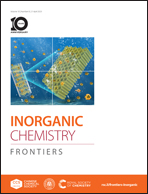Structure and optical property evolution in PbM(PO4)X (M = Zn, Sn; X = halogen): SHG effect and birefringence†
Abstract
Four new phosphates, namely, PbZn(PO4)F (1), PbSn(PO4)Cl (2), PbSn(PO4)Br (3) and PbSn(PO4)I (4), were successfully synthesized by hydrothermal and solid-state reaction methods. PbZn(PO4)F (1) was crystallized in a polar space group Pna21 and showed a significant SHG intensity of about 1.6 × KDP. PbSn(PO4)Cl (2) and PbSn(PO4)Br (3) were isostructural compounds, and they were crystallized in a monoclinic space group P21/n while PbSn(PO4)I (4) was crystallized in a triclinic space group P![[1 with combining macron]](https://www.rsc.org/images/entities/char_0031_0304.gif) . PbZn(PO4)F (1) features a new 3D framework while compounds 2–4 show a layered structure. Interestingly, the thermal stability and band gap of PbM(PO4)X are decreased with an increase of the atomic number of the halogen atom, while the rule for birefringence is the opposite. Our work revealed the evolution effects of the halogen atoms on the structure and optical properties of PbM(PO4)X compounds.
. PbZn(PO4)F (1) features a new 3D framework while compounds 2–4 show a layered structure. Interestingly, the thermal stability and band gap of PbM(PO4)X are decreased with an increase of the atomic number of the halogen atom, while the rule for birefringence is the opposite. Our work revealed the evolution effects of the halogen atoms on the structure and optical properties of PbM(PO4)X compounds.

- This article is part of the themed collections: FOCUS: Nonlinear Optical Materials and 2023 Inorganic Chemistry Frontiers HOT articles


 Please wait while we load your content...
Please wait while we load your content...